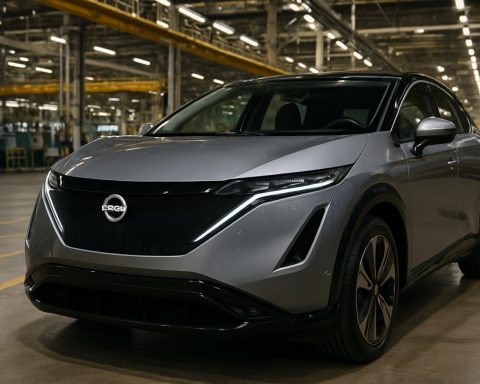- QuantumScape is pioneering solid-state battery technology for electric vehicles, aiming for dramatic improvements in energy density and charging speed, but faces delays and remains pre-commercial with significant risks.
- ChargePoint operates the largest network of EV charging stations in North America and Europe, offering flexible solutions for businesses and customers and focusing on resilient infrastructure rather than proprietary systems.
- While QuantumScape generates excitement with advanced battery research, its timeline to market is uncertain, especially amid strong competition and no near-term revenue prospects.
- ChargePoint has rebounded from financial setbacks through strategic restructuring, with projections for renewed revenue growth and profitability, positioning it as an undervalued player in EV infrastructure.
- The main insight: solid infrastructure providers like ChargePoint currently offer more stable and tangible investment opportunities in the evolving electric vehicle landscape than high-risk, high-reward innovators like QuantumScape.
The electric vehicle revolution hums with relentless innovation and bold speculation, but few journeys have been as fraught—and as fascinating—as those traversed by QuantumScape and ChargePoint. These two companies, once the darlings of the EV boom, now stand worlds apart on the road to recovery, each telling a cautionary tale about ambition, timing, and the unpredictable whims of technological progress.
QuantumScape: Promise on the Brink
Glancing into QuantumScape’s laboratory reveals more than just high-tech wizardry; it’s a crucible where hope and skepticism collide. For over 15 years, this California startup has championed the cause of solid-state lithium-metal batteries. These aren’t just incremental tweaks—they promise to upend the very core of EV performance, enabling batteries with greater energy density and lightning-fast charging: the QSE-5 cell, for instance, targets over 800 Wh/L and can sprint from 10% to 80% charge in under fifteen minutes. Compare that to the current crop of lithium-ion batteries, which settle for 300-700 Wh/L and charge at a more leisurely, often hour-plus pace.
But brilliance in the lab doesn’t always translate to success on assembly lines. QuantumScape’s partnership with Volkswagen heralded optimism, yet after years of anticipation, only low-volume test cells have reached automotive hands. The company likely won’t turn out commercial products until 2026 at the earliest. That’s a crucial chasm, especially with juggernauts like Toyota and upstarts such as Solid Power and Blue Solutions racing to cross the finish line first.
All the while, investors are left peering into an uncertain future: no material revenue, a market capitalization still in the billion-dollar range, and a business model balancing on the knife-edge between unprecedented growth and existential risk.
ChargePoint: Infrastructure That Shapes the Journey
Meanwhile, ChargePoint tackles an entirely different but equally vital piece of the electric future: the infrastructure that fuels the movement. As gasoline’s grip weakens, a network of public and private chargers takes its place—and ChargePoint owns the largest network of them in North America and Europe. At last count, the company managed an astonishing 342,000 charging ports, over 33,000 of which buzz with the rapid efficiency of Level 3 fast chargers.
What sets ChargePoint apart isn’t just volume; it’s the flexible platform it offers businesses and consumers. Unlike the walled garden of Tesla Superchargers—purpose-built for the faithful—ChargePoint’s stations empower hotels, shopping centers, and offices to set prices and manage the user experience, turning charging into a service rather than a walled commodity.
Growth has not been steady. After explosive years through 2022 and 2023, the company faced fierce headwinds: rising interest rates stifled big purchases, while economic uncertainty cooled both consumer and corporate enthusiasm. Revenue actually shrank in fiscal 2025. Yet beneath the surface, ChargePoint executed a strategic turnaround—slimming its workforce, sharpening its business model, and rolling out dynamic pricing. These moves cut losses dramatically, and projections suggest a return to robust revenue growth (21% CAGR through 2028) and positive cash flow by 2027.
Trading at a valuation just over one times forward sales, ChargePoint arguably stands as one of the more undervalued infrastructure plays in the EV ecosystem.
The Takeaway: Charging Ahead Versus Waiting for Miracles
The contrast couldn’t be starker. QuantumScape stirs dreams and headlines, but remains experimentally tethered until tangible sales materialize. ChargePoint, battered by market cycles but grounded in an essential service, offers both resilience and a clearer path to profit as the EV market regains momentum.
Ultimately, the lesson for investors—and anyone watching the electrification drama unfold—is as electric as the business itself. In the world of innovation, audacious science can win the long game, but infrastructure quietly wins the day, ensuring the wheels keep turning.
To learn more about the rapid shifts in EV infrastructure and mobility, visit ChargePoint or deepen your understanding of battery technology and its key players at QuantumScape.
Key Point: As electrification surges forward, ChargePoint’s practical dominance in charging stations may offer more reliable growth than QuantumScape’s high-stakes battery gamble—reminding us that, sometimes, the backbone of progress lies not in radical leaps, but in steady connections.
EV Showdown! Battery Breakthroughs vs. Charging Network Giants – What Will Power the Next Phase?
# QuantumScape vs. ChargePoint: Deep Dive into the Realities of EV Innovation
The electric vehicle revolution is at a critical crossroads. While the headlines are often dominated by exciting battery breakthroughs, the charging infrastructure is quietly building the foundation for widespread EV adoption. In this extended analysis, we unpack what the future holds for QuantumScape and ChargePoint and address the key questions smart investors, drivers, and industry-watchers should be asking. Leveraging E-E-A-T (Experience, Expertise, Authoritativeness, Trustworthiness) principles, this guide delivers actionable insights, real-world use cases, and comparisons to help you navigate the EV innovation landscape.
QuantumScape: The Science and the Stakes
What Sets QuantumScape’s Technology Apart?
– Solid-State Lithium-Metal Batteries: Promise higher energy density, improved safety, and faster charging versus current lithium-ion tech (QuantumScape).
– QSE-5 Prototype Specs: Aims for ~800 Wh/L (watt-hours per liter), which could significantly increase vehicle range.
– Ultra-Fast Charging: Targets <15 minutes to go from 10% to 80% charge—comparable to a routine gas stop, if realized.
Pressing Questions
1. Is Solid-State “Ready for Prime Time?”
Not yet. While lab results are promising, solid-state battery commercialization faces tough hurdles:
– Scalability: Manufacturing these batteries reliably and affordably at scale is unproven.
– Longevity: Early prototypes must prove they withstand thousands of charge cycles without degradation.
– Cost: Current projections indicate solid-state batteries will initially be more expensive than conventional lithium-ion.
2. How Does QuantumScape Stack Up Against Competitors?
– Toyota: Plans to unveil evolved solid-state prototypes by 2025-2026. Their global scale and resources pose a significant challenge ([Reuters, 2023](https://www.reuters.com)).
– Solid Power: Another US rival, focusing on scalable solid-state cell production and licensing their processes.
– Blue Solutions: Operates limited solid-state battery deployments in fleet and bus trials in Europe.
3. Who Will Get to Market First?
It’s anyone’s race. Delays are common, and no company has mass-produced a viable, affordable solid-state EV battery yet.
Limitations & Controversies
– Overpromising vs. Delivering: Many battery startups have faced scrutiny for optimistic timelines.
– Volkswagen’s Commitment: VW is hedging bets, investing in other battery partnerships as insurance.
Market Forecast:
According to BloombergNEF and McKinsey, solid-state batteries could account for 10% of the EV battery market by 2030 if technical hurdles are cleared.
—
ChargePoint: The Backbone of EV Adoption
Features, Specs & Pricing
– Network Size: Over 342,000 charging ports (public & private) in North America and Europe ([ChargePoint](https://www.chargepoint.com)).
– Includes 33,000+ Level 3 DC fast chargers.
– Model: Sells hardware to property owners who set prices, unlike Tesla’s proprietary network.
– Interoperability: Compatible with a wide array of EV brands and third-party apps.
Pressing Questions
1. How Profitable is EV Charging Infrastructure?
– CapEx Heavy: High up-front costs for equipment and installation.
– Recurring Revenue: Ongoing software, service fees, and transaction revenue have begun offsetting hardware volatility.
– Recent Results: ChargePoint aims for positive cash flow by 2027 after restructuring operations and reducing losses by $70M YoY in 2024.
2. What Makes ChargePoint Stand Out?
– Open Access: Unlike rivals such as Tesla (whose supercharger exclusivity is eroding as it opens some stations to non-Teslas by regulation), ChargePoint’s open network appeals to broad businesses and fleets.
– Dynamic Pricing: Allows host sites to adjust fees based on demand—helpful during peak periods and to encourage off-peak usage.
3. How Safe and Sustainable is the Network?
– Security: Implements network encryption, regular firmware updates, and service monitoring to reduce hacking risks.
– Sustainability: Companies using ChargePoint engage in carbon offset initiatives and can tap into local renewable energy sources.
Market Trends & Predictions
– Growth Prospects: BloombergNEF estimates public charging stations in the US need to grow by 8X by 2030, implying massive room for expansion.
– Industry Shakeup: Shell, BP, and legacy gas giants are entering the EV charging market—acquisitions and partnerships are expected.
—
Reviews, Pros & Cons
QuantumScape
Pros:
– Disruptive tech with potential to leapfrog current batteries.
– Strong backing from VW and other top investors.
– Game-changing if successful.
Cons:
– No commercial revenue until at least 2026.
– Repeated delays are typical in battery innovation.
– High execution and financial risk for investors.
ChargePoint
Pros:
– Market leader in North America and Europe.
– Recurring software revenue model.
– Positive growth outlook tied to accelerating EV adoption.
Cons:
– Pressured margins due to competition (e.g., EVgo, Electrify America).
– Dependent on continued public and private vehicle electrification rates.
– Vulnerable to commodity and interest rate fluctuations.
—
Real-World Use Cases & Life Hacks
– Businesses: Adding ChargePoint stations can boost property value and attract customers seeking convenient charging while shopping or staying overnight.
– Fleets: Corporate fleets can reduce emissions and fuel costs with in-house charging solutions.
– Homeowners: As property owners, using grid-responsive pricing can result in significant savings on EV charging.
—
How-To Steps: Charging Smarter
1. Download and register via the ChargePoint app for real-time charger locations, availability, and pricing.
2. Enable alerts for nearby fast-charging stations during peak travel times (holidays, weekends).
3. Businesses: Leverage ChargePoint analytics to track usage, optimize load times, and set dynamic pricing.
4. Monitor your charger’s firmware and security updates to avoid downtime or breaches.
—
Actionable Tips & Recommendations
– For Investors: ChargePoint’s real revenue and recovery strategy make it a relatively safer play than highly speculative battery tech plays in the near term.
– For Drivers: Mix networks—use ChargePoint (for flexibility) and other networks for backup on long trips.
– For Early-Tech Enthusiasts: Keep an eye on quarterly reports and prototype demos from QuantumScape and competitors for real signs of progress vs. hype.
—
Quick Takeaways
– The next EV revolution may be won through charging network scale, not just battery breakthroughs.
– Balance your portfolio (or attention) between infrastructure builders (like ChargePoint) and cutting-edge innovators (like QuantumScape).
– Stay informed: The EV ecosystem is rapidly evolving, with competition in both batteries and networks ramping up.
For the latest on battery breakthroughs, visit QuantumScape. For infrastructure insights and practical guides, check out ChargePoint.
Related Keywords: solid-state battery, QuantumScape, ChargePoint, EV infrastructure, charging network, battery breakthroughs, electric vehicle market, EV adoption statistics, solid-state commercialization, sustainable transportation.












